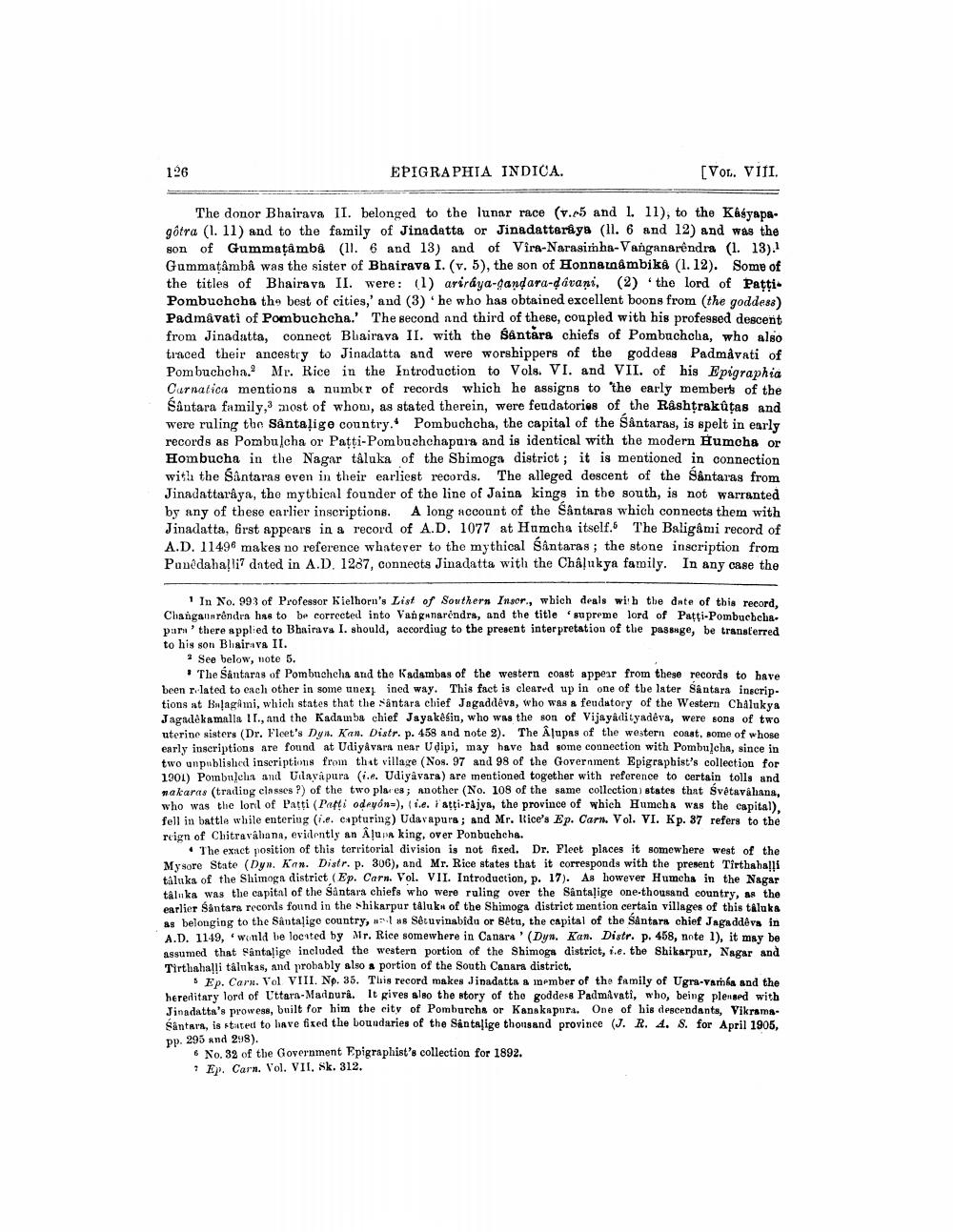________________
126
EPIGRAPHIA INDICA.
[VOL. VIII.
The donor Bhairava II. belonged to the lunar race (v.e5 and 1. 11), to the Kagyapagôtra (1.11) and to the family of Jinadatta or Jinadattaraya (ll. 6 and 12) and was the son of Gummațâmba (11. 6 and 13) and of Vira-Narasimha-Vanganarendra (1. 13). Gummatâmbâ was the sister of Bhairava I. (v. 5), the son of Honnanâmbikå (1.12). Some of the titles of Bhairava II. were: (1) ariraya-gandara-davaņi, (2) the lord of Patti. Pombuchcha the best of cities,' and (3) he who has obtained excellent boons from the goddess) Padmavati of Pombuchcha.' The second and third of these, coupled with his professed descent from Jinadatta, connect Blairava II. with the Santars chiefs of Pombuchcha, who also traced their ancestry to Jinadatta and were worshippers of the goddess Padmavati of Pombuchcha. Mr. Rice in the Introduction to Vols. VI. and VII. of bis Epigraphia Carnatica mentions a number of records which he assigns to the early members of the Santara family, most of whom, as stated therein, were feudatories of the Rashtrakûtas and were ruling the Sântaļige country. Pombuchcha, the capital of the Såntaras, is spelt in early records as Pombulcha or Patti-Pombushchapura and is identical with the modern #umcha or Hombucha in the Nagar tåluka of the Shimoga district; it is mentioned in connection with the Sintaras even in their earliest records. The alleged descent of the Sântaras from Jinadattaraya, the mythical founder of the line of Jaina kings in the south, is not warranted by any of these carlier inscriptions. A long account of the Sântaras which connects them with Jinadatta, brst appears in a record of A.D. 1077 at Humcha itself. The Baligami record of A.D. 11496 makes no reference whatever to the mythical Sântaras ; the stone inscription from Panêdaha!li7 dated in A.D. 1287, connects Jinadatta with the Chalukya family. In any case the
In No. 993 of Professor Kielhorn's List of Southern Inser., which deals with the date of this record, Changannröndra has to be corrected into Vangunarendra, and the title supreme lord of Patti-Pombuchchapara'there applied to Bhairava I. should, according to the present interpretation of the passage, be transferred to his son Bhairava II.
? See below, note 5.
The Santaras of Pombuchcha and the Kadambas of the western coast appear from these records to have been related to exch other in some unex: ined way. This fact is cleared up in one of the later Sântara inscriptions at Bulagimi, which states that the såntara chief Jogaddeva, who was a feudatory of the Western Chalukya Jagadėkamalla II., and the Kadamba chief Jayakésin, who was the son of Vijayadityadeva, were sons of two uterine sisters (Dr. Fleet's Dyn. Kan. Distr. p. 458 and note 2). The Aļupas of the western coast, some of whose early inscriptions are found at Udiyåvara near Udipi, may have had some connection with Pombulcha, since in two unpublished inscriptions from that village (Nos. 97 and 98 of the Government Epigraphist's collection for 1901) Pombucha and Udayapura (i.. Udiyavara) are mentioned together with reference to certain tolls and wakaras (trading classes ?) of the two pla es; another (No. 108 of the same collection states that Svētaváhana. who was the loril of Patti (Pafti odeyon=), (i.e. fatti-rajya, the province of which Humche was the capital). fell in battle while entering (e. capturing) Udavapurs; and Mr. Rice's Ep. Carn. Vol. VI. Kp. 37 refers to the reign of Chitravábana, evidently an Aļuva king, over Ponbuchcha.
The exact position of this territorial division is not fixed. Dr. Flect places it somewhere west of the Mysore State (Dyn. Kan. Distr. p. 306), and Mr. Rice states that it corresponds with the present Tirthahalli tluka of the Shimoga district (Ep. Carn. Vol. VII. Introduction, p. 17). As however Humcha in the Nagar taluka was the capital of the Sintara chiefs who were ruling over the Sântalige one-thousand country, as the earlier Santara records found in the Shikarpur taluks of the Shimoga district mention certain villages of this taluka as belonging to the Santalige country, #alas Sécuvinabidu or setu, the capital of the Sântara chief Jagaddēva in A.D. 1149, would be located by Mr. Rice somewhere in Canara' (Dyn. Kan. Distr. p. 458, note 1), it may be assumed that Santalige included the western portion of the Shimoga district, i.e. the Shikarpur, Nagar and Tirthahalli talnkas, and probably also a portion of the South Canara district.
Ep. Carn. Vol VIII. Np. 35. This record makes Jinadatta a member of the family of Ugra-vanka and the hereditary lord of Uttara-Madurâ. It gives also the story of the goddess Padmavati, who, being plenged with Jinndatta's prowess, built for him the city of Pomburchs or Kanakapura. One of his descendants, VikramaSántara, is stated to have fixed the boundaries of the Santaļige thousand province (J. R. A. $. for April 1905, pp. 295 and 298).
6 No. 32 of the Government Epigraphist's collection for 1892. 7 Ep. Carn. Vol. VII, Sk. 312.




